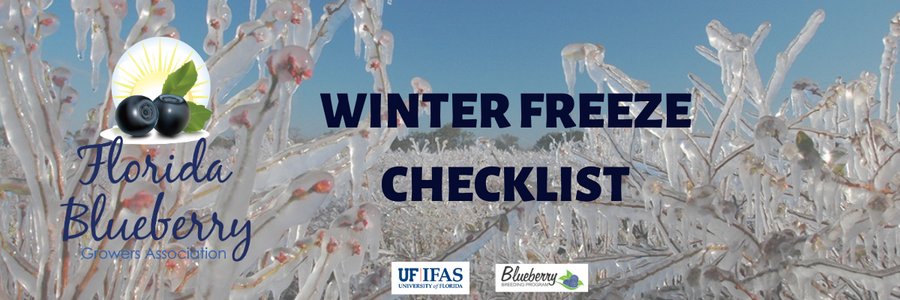With freezing temperatures on the way this weekend, the following is a list of activities
for freeze preparation. The list was originally published by Mike Mainland in the North
Carolina Blueberry News, Vol. 7, No. 1 and has been modified by UF IFAS faculty and
FBGA board members. Links for some additional freeze protection resources are
included at the end.
1. Flush all overhead sprinklers to clear debris – remove heads and flush.
2. Test and service the pumping units, replace filters and have spare filters available.
3. Treat diesel tanks for water and algae.
4. Check lines and sprinklers in the field for leaks and clogged nozzles.
5. Check water pressure on ends of distant lines.
6. Make sure drainage in and around fields is adequate. Make sure roadways around
and through the fields will withstand traffic at night during irrigation.
7. Remove or relocate any equipment that may impede or pose a danger to vehicular
traffic.
8. Have a (remote controlled, magnetic roof mounted) high-intensity spotlight ready to
plug into the truck to check sprinklers.
9. Put shielded minimum thermometers in cold, average, and warm areas of fields – at
the average height of the middle of the bushes,
10. Consider purchasing weather stations that communicate real-time weather
conditions to computers and smart phones.
11. Hang some ribbons on trees or poles around fields to detect slight breezes.
12. Identify a good source of agricultural weather information and watch it closely.
Consider subscribing to a weather service that issues freeze warnings.
13. Consider purchasing a monitor that calls you when the temperature gets low.
14. Consider purchasing a hand-held wind meter or anemometer to measure wind
speed.
15. Consider purchasing a sling psychrometer to measure wet bulb and dry bulb
temperatures, relative humidity, and dew point.
16. Have rain suits and boots available for everyone responsible for checking the
irrigation system.
17. Have wires available to unclog nozzles.
18. Have tools and replacement parts that are necessary to exchange nozzles and/or
sprinklers.
19. Be certain you know the “safe cut off temperature” before you shut down your
overhead freeze protection irrigation. This temperature can be as high as 40
degrees F if the dew point is low and wind is high.
20. Fill all vehicles with fuel before the freeze event.
21. Have help available or on call if needed for emergencies.
Additional resources –
Protecting blueberries from freezes in Florida.
https://edis.ifas.ufl.edu/pdf/HS/HS21600.pdf
Cold Protection toolkit. Florida Automated Weather Network (FAWN), Univ. of Florida
Extension. https://fawn.ifas.ufl.edu/tools/coldp/
AgroClimate website. http://agroclimate.org/
University of Georgia Extension Circular 1128, Preparing Your Blueberry Freeze
Protection System.
https://secure.caes.uga.edu/extension/publications/files/pdf/C%201128_2.PDF






